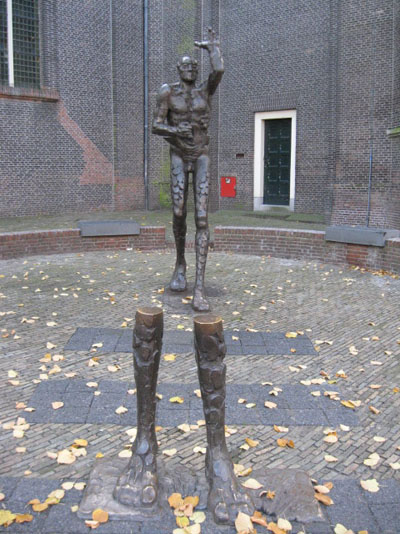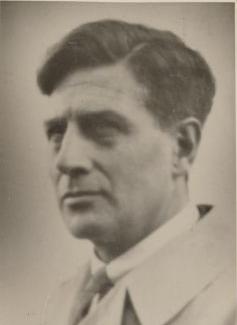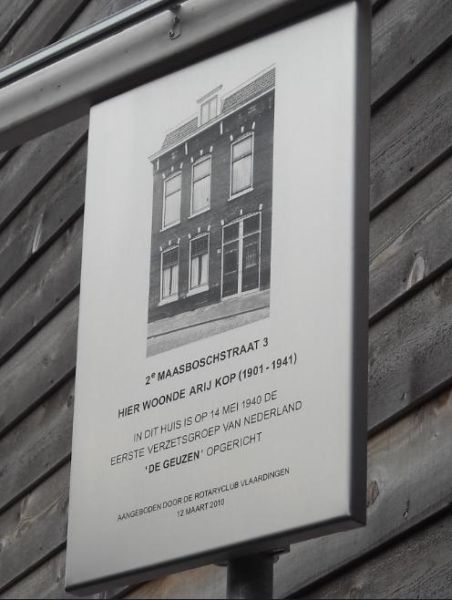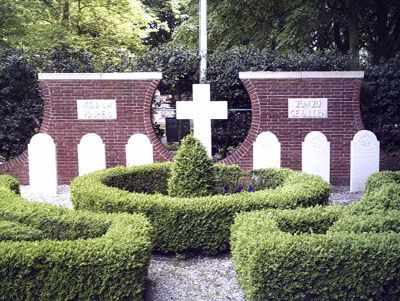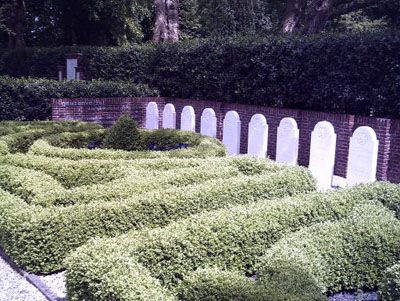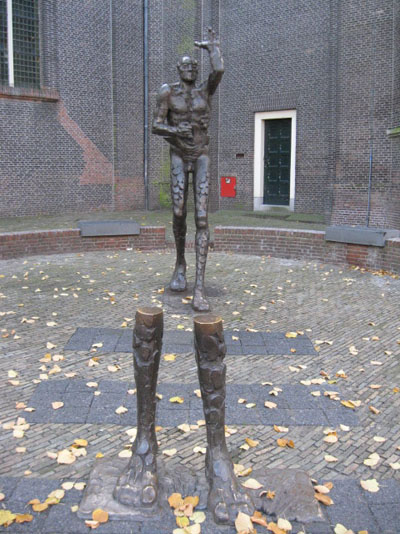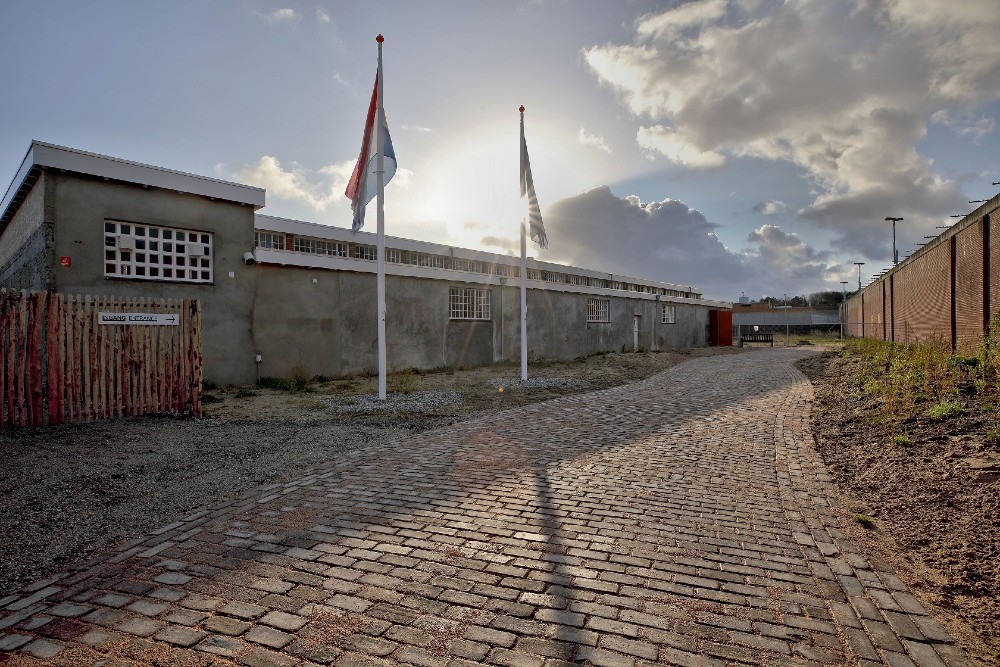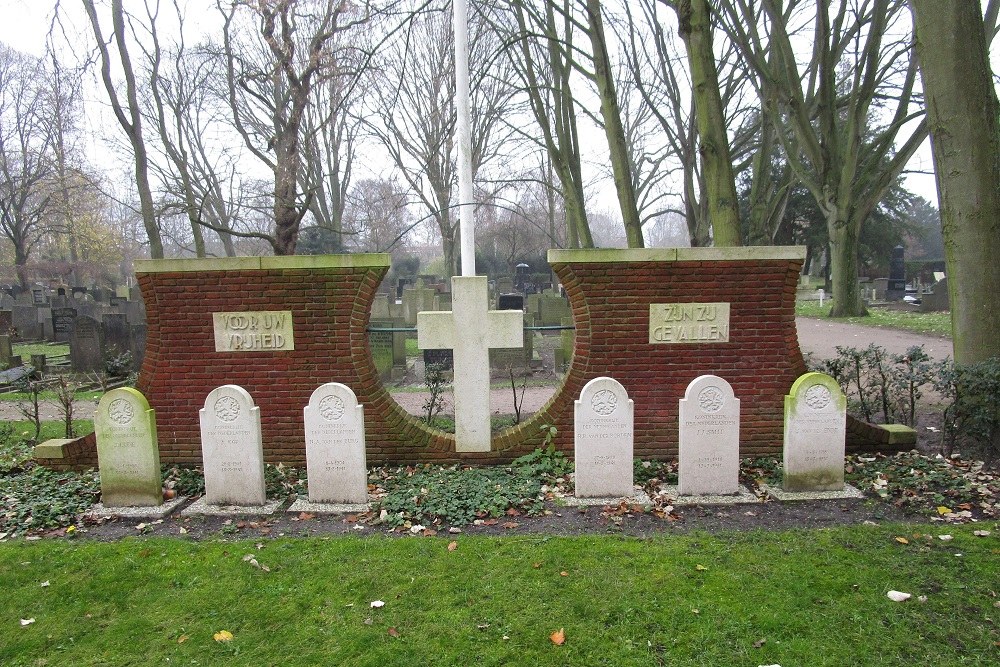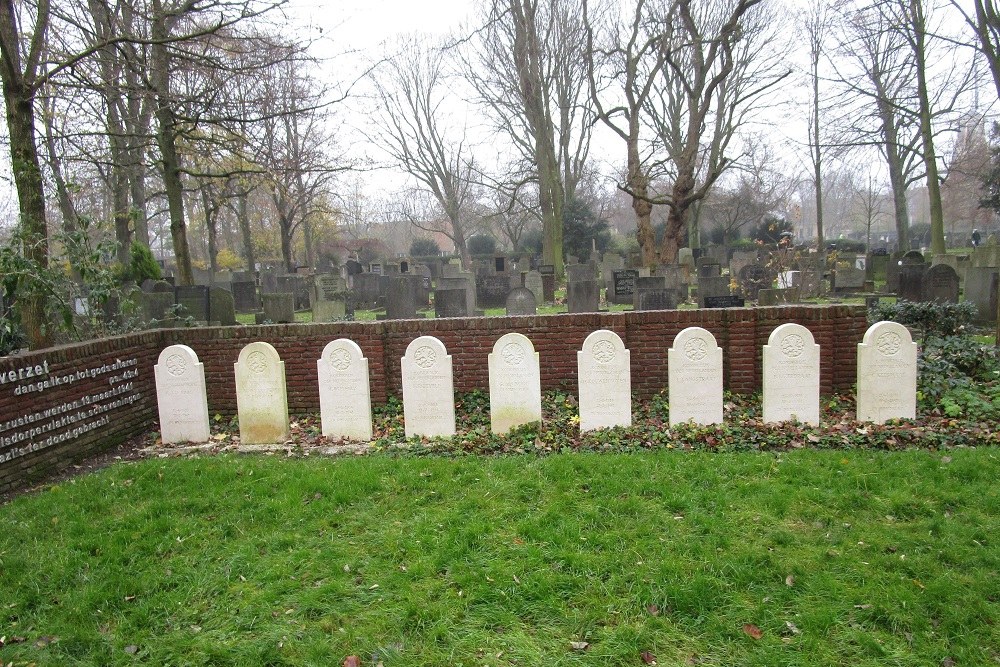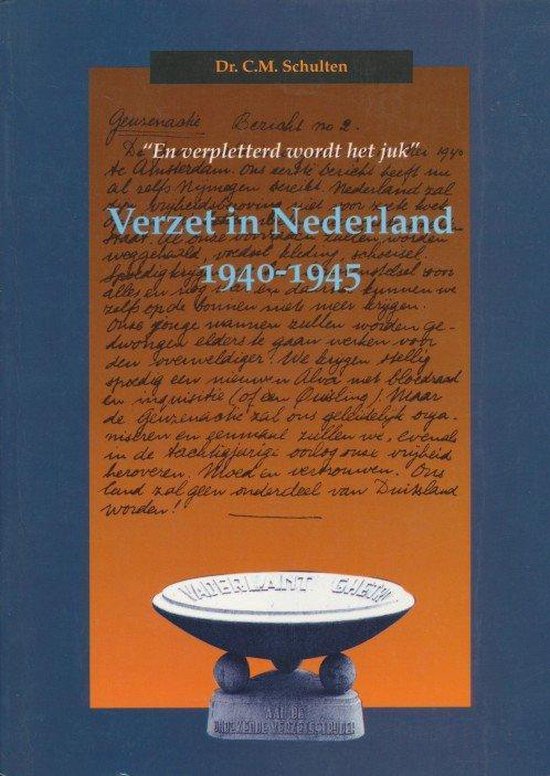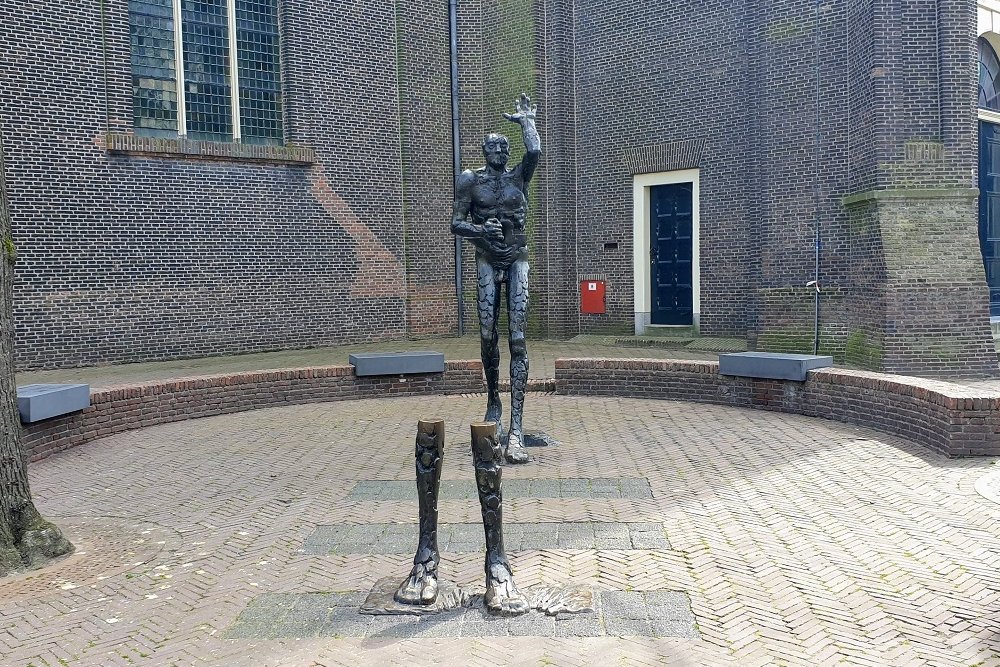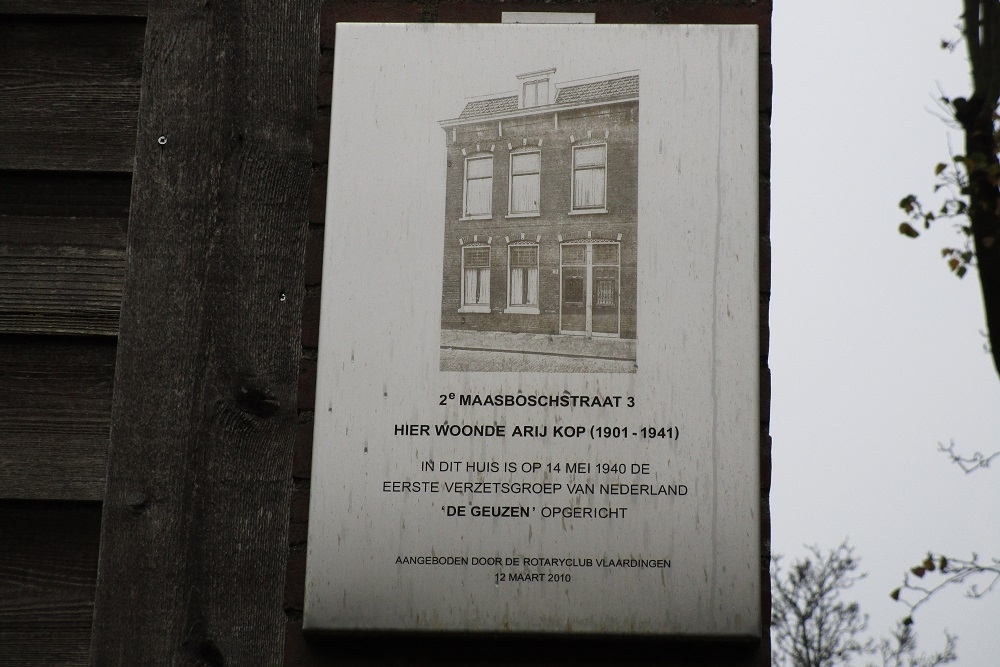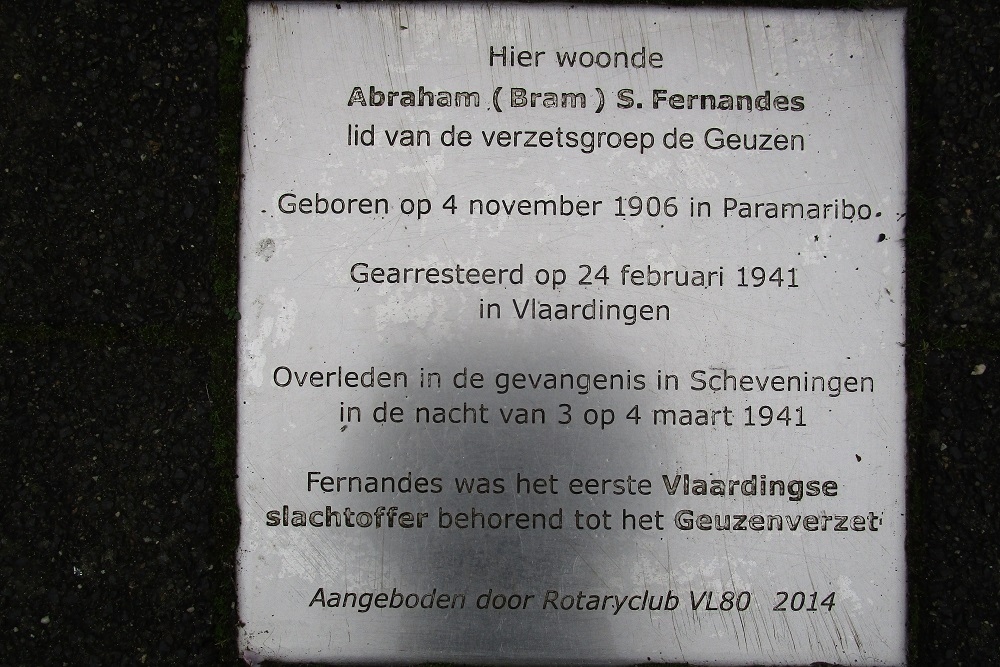Introduction
After the capitulation in May 1940, the major part of the Dutch population made sure the usual way of life took place, which required two things: for the economy to keep running and for the German control to remain limited. This required a good cooperation with the occupier so that they would see no reason to interfere more intensively in the Dutch government and economy. Resistance would only mean throwing away their influence on the course of the occupation. All Dutch authorities, including the fled cabinet, initially asked the population to obey the occupier, avoid resistance and get back to daily life. The major part of the population did. Still, there was resistance, despite the authorities appeal. There were people who turned away from the German occupiers from the start and tried to work against them. The resistance group 'De Geuzen' (The Beggars) was immediately founded on May 14th, 1940 in Vlaardingen. This was the first resistance group of the Netherlands.
Definitielijst
- capitulation
- Agreement between fighting parties concerning the surrender of a country or an army.
- Resistance
- Resistance against the enemy. Often also with armed resources.
Images
Resistance group of the very beginning
Foundation
One of the people to immediately turn away from the German occupier was Bernardus IJzerdraat. IJzerdraat was a resident of Rotterdam and worked as a teacher in Vlaardingen and Schiedam. The results of the May 14th, 1940 bombing of Rotterdam made such a profound impression on him that he decided to resist. He foresaw "a new Alva soon, with blood council and inquisition". In line with this comparison with the Eighty Years' War, he named his resistance 'Geuzenactie' (Beggars' action).
By spreading his Geuzen message (a chain letter) he hoped to form a Geuzen army. The first message was immediately distributed on May 15th. This message was lost though. In the ‘Bericht no.2’ (message number 2) of May 18th, IJzerdraat notified the reader about a foresight of the course of the occupation: “All of our stocks will be taken away, food, clothes, footwear. Soon we will have a coupon system for everything and after that we will not be able to get anything, not even with the coupons. Our young men will be forced to work elsewhere for the conqueror." Probably to impress people, IJzerdraat deliberately exaggerated in writing the message. He wrote, for example, that the action had started in Amsterdam and, as a result of many multiplications, had even reached Nijmegen. This was actually not the case at that time.
IJzerdraat found an ally in Jan Kijne from Vlaardingen. Both men agreed that the Germans had to be sabotaged and spied on, and that information had to be passed on to England. Kijne regularly walked with the walking club of Vlaardingen, W.S.V. Flardinga, of wich Ary Kop was a board member. The hikers could discreetly execute tasks of the Geuzen. IJzerdraat, Kijne and Kop decided to organize a resistance movement this way. IJzerdraat would work on the chain letters and contacts with England. Kop became the leader of the Geuzenleger of Vlaardingen. The armies were also founded in other places. People who wanted to join had to take the Geuzen oath: “I vow to be a proper Dutch Geus in these serious times and to totally and unconditionally keep to the Geuzen law and the commander's rules. I declare to approve that, as soon as my promise is violated in any way, all my rights and properties will be passed on to and for the benefit of the Geuzen army, or when this is not discontinued, to and for the benefit of the Dutch polity."
First acts and expansion
After the foundation, the organization was not in command of weapons. It was decided to make clubs and a revolver was stolen from a German soldier. Such activities were not of high priority though, because the most important objectives were sabotage and collecting information. Data were gathered about German troops, headquarters and ships in the harbor. Lists of NSB members and 'moffenmeiden' (term of abuse for Dutch girls who had relations with Germans) were also drawn up. Sabotage was committed, though on a small scale. The telephone lines which connected the searchlight installations and the anti-aircraft guns in Vlaardingen were destroyed seven times in 1940. Through an appeal in the local paper and posters, the occupier made clear in September that year that “the German Wehrmacht would employ the toughest measures to the city of Vlaardingen and its inhabitants". When a saboteur was caught red-handed, live ammunition would be fired immediately. After this, it was decided to stop the acts of sabotage.
The leaders of the Geuzen hoped to acquire a large resistance group through their chain letters, which did happen. Soon, armies were created in Rotterdam, Maassluis, Delft, Zwijndrecht and Dordrecht. They had hundreds of members. Historian A. Overwater managed to create a list with the names of over 280 Geuzen. And these were only the Geuzen who would be arrested. The actual number of members and people involved was probably a lot higher. From August 1940 onwards, a pamphlet called 'De Geus van 1940' (The Beggar of 1940) was written for the members of the resistance group.Definitielijst
- NSB
- National Socialist Movement. Dutch political party sympathising with the Nazis.
- resistance
- Resistance against the enemy. Often also with armed resources.
- Wehrmacht
- German armed military forces, divided in ground forces, air force and navy.
Images
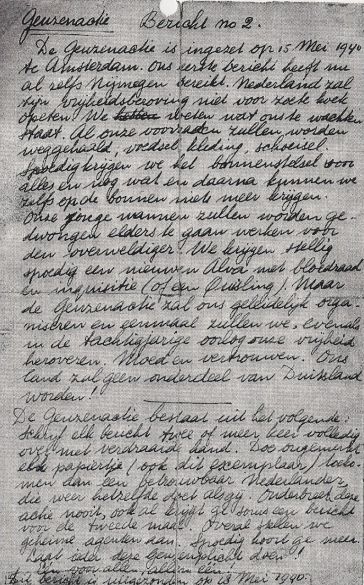 Geuzen message number 2 Source: Stadsarchief Vlaardingen.
Geuzen message number 2 Source: Stadsarchief Vlaardingen.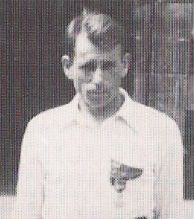 Ary Kop Source: Stadsarchief Vlaardingen.
Ary Kop Source: Stadsarchief Vlaardingen.Trial and sentence
Betrayal and apprehension
However, fate soon caught up with the Geuzen. Daan van Striep, a young man from Arnhem who lived in lodgings in Schiedam on weekdays and worked at the shipyard of Wilton-Feijenoord, obtained an issue of ‘De Geus van 1940’ in November 1940. He received this from a colleague, the mechanic Johannes Smit from Vlaardingen. Back in Arnhem, Van Striep told people he knew about the group of the Geuzen. But his stories were also heard by an NSB group leader. He reported the stories to the Germans and the Sicherheitspolizei (security police) started an investigation.
Through Van Striep, the trail soon led to Schiedam, where he was arrested on November 19th. Soon after that, his colleague Johannes Smit was also arrested by the Germans. In a search in his house, pictures of members the royal family and a copy of 'De Geus van 1940' were found. During the interrogations, Smit talked. Because many of the Geuzen were inexperienced resistance fighters, the Germans were able to round up the network quickly. Many of the Geuzen knew each other, so there was no secrecy. They were not able to warn each other in time. On November 21st, Ary Kop's home was also searched. When searching the house, where at that time only the two daughters of Kop were present, illegal magazines, explosives and weapons were found. Kop was warned, but he went home with his wife anyway. Both were arrested. Kop's wife was soon released though, because she was five months pregnant with their third daughter.
The Geuzen of Vlaardingen were first locked up in a basement of the police station in Vlaardingen. After that they were, like the other arrested Geuzen, transferred to the house of detention in Scheveningen, also called the 'Oranjehotel'. Here they were interrogated and some also tortured. The leader of the Geuzen of Maassluis, Jacobus Boezeman, shared cell 333 with the Geus George den Boon from Lekkerkerk. Late in the evening of January 8th 1941, he was taken from his cell by three Polizisten of the Sicherheitsdienst and transferred to the headquarters of the SD at the Binnenhof for interrogation. During this interrogation he was tortured horribly. After he was taken back to the Oranjehotel, he died the next morning of his injuries. When he was still conscious that night, he told the guards that the Germans had cut his wrists. His back and face were also covered with injuries and contusions.
Ary Kop was locked up alone in cell 603. He wrote notes to his wife on toilet paper, which were smuggled out with the dirty laundry. These also show that he was seriously tortured during interrogations. “The various stains on my shirt will make you wonder. They will speak for themselves later. I will tell you. They hit me so, until I tumbled down. Then they poured a beer bottle (which was recently emptied and refilled with water) in my mouth and nose and when I got to my side again or tried to get up, they kicked me until I was on my feet and then the hitting started all over again. No, if live to see it, after the war I will show my trails of blood on the wallpaper in the Binnenhof."
On February 24th 1941, the trial against the arrested Geuzen began. On this day another 42 people were rounded up in Vlaardingen by the German police because of possible involvement in the Geuzen resistance. One of them was Abraham Fernandes, a Surinamese Jew. He was also transferred to the Oranjehotel in Scheveningen. Which acts he executed as a Geus is unknown, as is what happened during his imprisonment and interrogations. What we do know is that he died of torture during his imprisonment, but even the exact date of his death is unclear. His gravestone and records mention March 4th 1941, but his wife was already summoned to the Binnenhof by the Germans on March 3rd. They then told her that her husband died and they showed her the body.
Eigtheen deaths at the Waalsdorpervlakte
Possibly as a consequence of the fact that the trial against the Geuzen coincided with the February strikes of February 25th and 26th, harsh punishments were given to scare the Dutch population. The following sentence was included in the announcement: "So that anyone who plans to offer help to England or cause the German Wehrmacht harm, knows he is playing with his life." Eighteen Geuzen were sentenced to death, including the leaders Bernardus IJzerdraat and Ary Kop. For three underage Geuzen (Willem Keesmaat, L. Van den Hoff and S. Menko) the death penalty was eventually changed to life imprisonment. In their place, three communist February strikers (Hermanus Coenradi, Joseph Eijl and Eduard Hellendoorn) were added to the Geuzen who were sentenced to death.
On March 13th, 1941 Reichskommissar für die besetzten Niederlande Arthur Seyss-Inquart was granted permission by the German Reichsminister Hans Lammers to execute the sentences of the eighteen men. They visited the prison minister and sang the Wilhelmus in their cell. After that they were transferred to the Waalsdorpervlakte and were fusilladed there.
Bernardus IJzerdraat (49 years old)
Jan Kijne (46 years old)
Ary Kop (40 years old)
Jacob van der Ende (22 years old)
Leendert Keesmaat (29 years old)
Hendrik Wielenga (37 years old)
Johannes Smit (30 years old)
Frans Rietveld (36 years old)
Leendert Langstraat (31 years old)
Jan Wernard van den Bergh (47 years old)
Albertus Johannes de Haas (37 years old)
Reijer Bastiaan van der Borden (32 years old)
Nicolaas Arie van der Burg (36 years old)
George den Boon (21 years old)
Dirk Kouwenhoven (24 years old)
Eduard Hellendoorn (28 years old)
Hermanus Coenradi (31 years old)
Joseph Eijl (44 years old)
It was the first mass execution in the Netherlands. The fusilladed men were buried at the Waalsdorpervlakte by the occupier. At that time, another 157 Geuzen were held captive in the Oranjehotel. They were eventually sent to various concentration camps. 63 of them did not survive the imprisonment.
As a result of the executions, resistance fighter Jan Campert wrote 'het lied der achttien dooden' ('the song of the eighteen dead'). The song of seven stanzas appeared in 1943, when it was illegally published by De Bezige Bij. Campert had then already died, on January 12th 1943, in the concentration camp Neuengamme. He was arrested for helping Jewish refugees. The first stanza of 'het lied der achttien dooden' goes:
A cell two metres long for me
But not two metres wide,
That plot of earth will smaller be
Whose whereabouts they hide;
But there unknown my rest I’ll take,
My comrades with me slain,
Eighteen strong men saw morning break -
We’ll see no dawn again.
Definitielijst
- concentration camp
- Closed camp where people are being held captive that are considered to be anti- social, enemies of the state, criminal or unwanted individuals. These groups mostly do not get a fair trial or are condemned to doing time in a camp.
- NSB
- National Socialist Movement. Dutch political party sympathising with the Nazis.
- Reichskommissar
- Title of amongst others Arthur Seyss-Inquart, the highest representative of the German authority during the occupation of The Netherlands.
- resistance
- Resistance against the enemy. Often also with armed resources.
- Wehrmacht
- German armed military forces, divided in ground forces, air force and navy.
Images
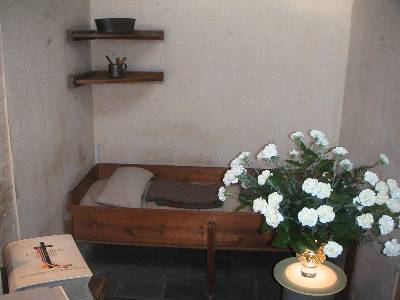 A cell in the Oranjehotel. Source: Stichting Oranjehotel.
A cell in the Oranjehotel. Source: Stichting Oranjehotel.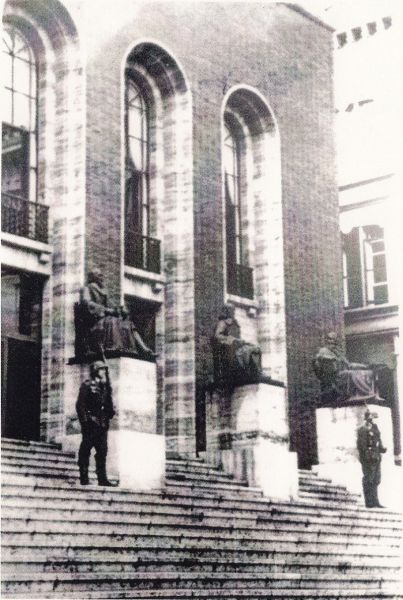 The building of the Supreme Court during the trial against the Geuzen. Source: Stadsarchief Vlaardingen.
The building of the Supreme Court during the trial against the Geuzen. Source: Stadsarchief Vlaardingen.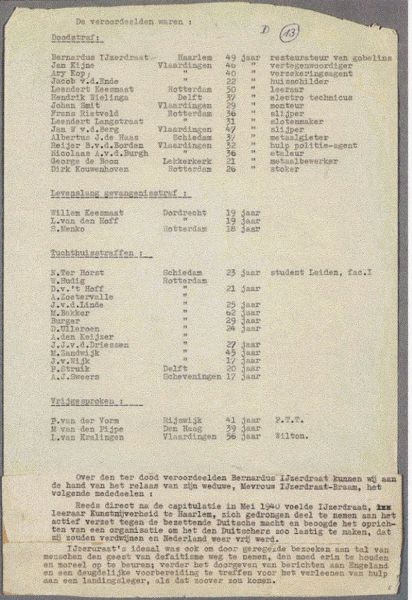 The conviction of the Geuzen. Source: Stadsarchief Vlaardingen.
The conviction of the Geuzen. Source: Stadsarchief Vlaardingen.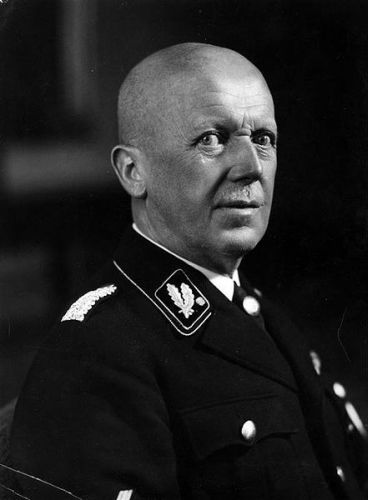 Reichsminister Lammers approved the executions of the Geuzen. Source: Bundesarchiv.
Reichsminister Lammers approved the executions of the Geuzen. Source: Bundesarchiv.Aftermath
Reburied
After the war, the many (mass) graves at the Waalsdorpervlakte were opened to identify the people buried there and to rebury them elsewhere with honor. Six Geuzen were buried at the cemetery Emaus in Vlaardingen: Reijer Bastiaan van den Borden, Nicolaas Arie van den Burg, Jacob van der Ende, Jan Kijne, Ary Kop and Johannes Smit.
Bernardus IJzerdraat, Dirk Kouwenhoven, Leendert Langstraat and Frans Rietvelt were given their final resting-place at the Dutch military cemetery in Loenen. The grave of Abraham Fernandes is also located here. Jan Wernard van den Bergh is buried at the Algemene Begraafplaats in Schoonhoven, George den Boon in Lekkerkerk, Albertus Johannes de Haas in Schiedam, Leendert Keesmaat in Dordrecht and Hendrik Wielenga in Delft.
The three February strikers who were fusilladed together with the Geuzen were reburied at the Dutch military cemetery in Loenen.
At the Waalsdorpervlakte there is a monument in memory of the people who were executed there by the Germans. Parts of the monument include four bronze fusillade crosses and the clock chair with bourdon clock. Every year on May 4th, a memorial ceremony is held for the victims of the war.
In memory of the Geuzen
Vlaardingen has several locations and events which still remind people of the Geuzen resistance. For example, in 1980 the Stichting Geuzenverzet (foundation Beggars’ resistance) was founded in memory of the Geuzen. The foundation's aim is to preserve and promote democracy in the Netherlands and to increase the alertness to all types of dictatorship, discrimination and racism. Every year the Geuzen medal is handed out to people or organizations with the same goal. This happens on March 13th, the day on which fifteen members of the Geuzen group were executed in the Grote Kerk (great church) of Vlaardingen in 1941. This church is next to the Geuzen monument and across from the old town hall where members of the Geuzen group were held captive in the basement. Well-known recipients of this medal include the Colombian politician Ingrid Betancourt, the former West German President Richard von Weizsäcker, the Anne Frank Stichting (Anne Frank Foundation), in 2002 Asma Jahangir, the Pakistani lawyer and advocate of women rights, and in 2003 the international children's rights organization Defence for Children International.
The Geuzen monument next to the Grote Kerk in Vlaardingen was revealed by Queen Beatrix on March 12th 1983. The monument was made by Leen Droppert and it is made of bronze, bricks, natural stone and paving bricks. The Geuzen monument depicts a determined human figure. The fact that the monument depicts a walking figure means that it is his assignment to deliver the message in the future. He cannot stand still. One hand is raised, which signifies a warning, and he protects his own body with his other hand. With his clenched fist, he tries to defend himself against the enemy. The circular wall elucidates all this once more, the sign says: ‘verzet tegen de vijand geschiedt steeds op den juisten tijd’ (resistance against the enemy happens at the right time). There is a crossing of black stripes from the statue to the former police station at the market where the Geuzen were taken after their apprehension by the Germans. There are eighteen ominous black stripes, the same amount as the deaths at the Waalsdorpervlakte. At the crossing are two severed feet, which signify the abruptly ended lives of these eighteen men.
A year later, a monument was placed at the cemetery Emaus in memory of the fifteen killed Geuzen. Six of them were actually buried here. The other nine Geuzen who died, lie elsewhere. Symbolic gravestones were placed in their memory. A wall is built near the graves with the line: ‘Dan ga ik op naar Gods altaren Ps4’ (Then I will go to the altar of God Ps4). Beneath that it says: ‘Zij die hier rusten werden op 13 maart 1941 op de Waalsdorpervlakte te Scheveningen door de Nazi’s ter dood gebracht’ (Those who lie here were killed at the Waalsdorpervlakte in Scheveningen by the Nazis on March 13th 1941). Behind the gravestones is a wall with a white cross in a half-open circle.
Definitielijst
- democracy
- From the Greek: demos (the people) kratein (rules). Democracy is a form of government elected by the majority of the people in which the people can check on the leaders and have the government resign in case a majority of the people no longer agrees with the government.
- dictatorship
- A form of government where the power in a country is in the hands of one person, the dictator. Originally a Roman regime in case of an emergency where total power would rest with one person during six months in order to face a crisis.
- Nazi
- Abbreviation of a national socialist.
- racism
- Discrimination based on race.
- resistance
- Resistance against the enemy. Often also with armed resources.
Images
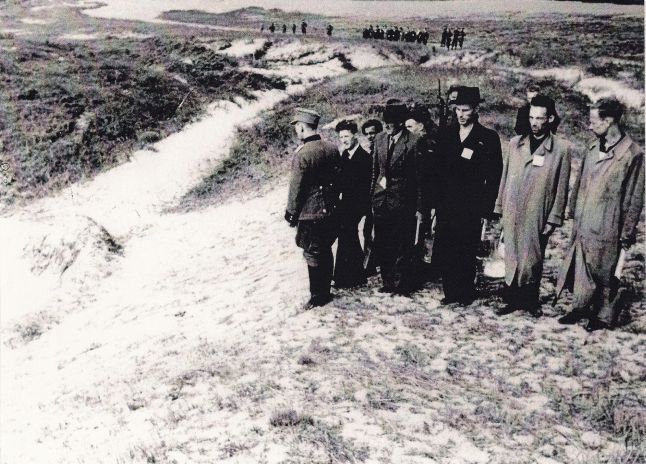 Exhumation of the members of the Geuzen Source: Stadsarchief Vlaardingen.
Exhumation of the members of the Geuzen Source: Stadsarchief Vlaardingen.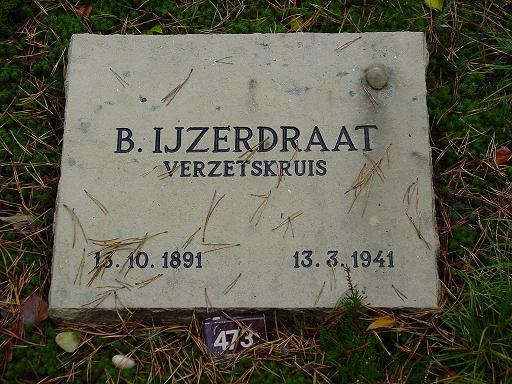 The grave of IJzerdraat at the Field of Honour in Loenen. Source: Vereniging Erepeloton Waalsdorp.
The grave of IJzerdraat at the Field of Honour in Loenen. Source: Vereniging Erepeloton Waalsdorp.Information
- Article by:
- Pieter Schlebaum
- Translated by:
- Kim van Dijk
- Feedback?
- Send it!
Related sights
Related books
Sources
- JONG, L. DE, Het Koninkrijk der Nederlanden in de Tweede Wereldoorlog 4, Staatsuitgeverij, Den Haag, 1969.
- OVERWATER, A., De Geuzen van 1940, Niet bekend, Barendrecht, 1996.
- PAAPE, H., De Geuzen, 1965.
- ROEGHOLT, R. e.a., Het verzet 1940-1945, Unieboek b.v., Weesp, 1985.
- SCHULTEN, C., En verpletterd wordt het juk, Sdu Uitgeverij Koninginnegracht, Den Haag, 1995.
- NIOD, Archief Wehrmachtsbefehlshaber in den Niederlanden, nummer 296: de veroordeling van de Geuzengroep.
- Stadsarchief Vlaardingen, archiefnummers Hi-669 en Hi-1566 (foto's)
- Anderson, J. en Middelkoop, E., De Geuzen in Vlaardingen (2008)
- Idzinga, S., Fernandes, een vergeten Vlaardingse Geus (2009)
- Historische Vereniging Maassluis
